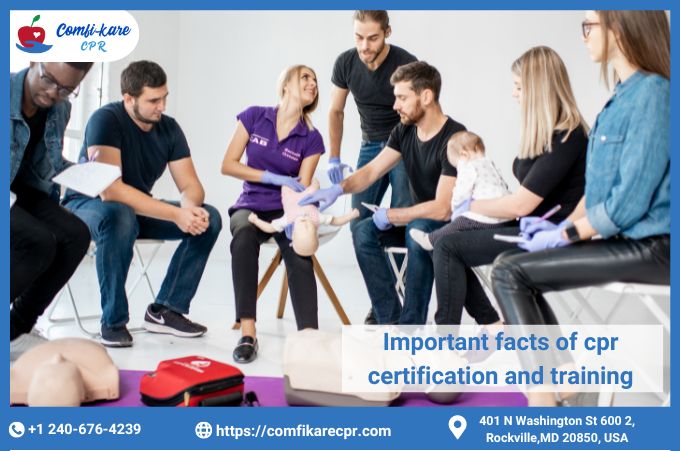
Do you remember the last time someone you know had to face breathing issues? Well, this is when CPR training, or say Cardiopulmonary Resuscitation, comes into the picture. In short, it’s not necessary that only healthcare professionals should know about it. Everyone should know about it because you can really save people whenever an emergency happens.
In this article, we are here to tell you about the importance of this certification. We will also talk about some important facts. Read completely so that you can make a difference:
What Is CPR.
CPR (Coronalysis Resuscitation) is a type of emergency breathing technique used to maintain oxygen and blood flow to organs during euthanasia, using chest compressions and rescue breathing until medical attention arrives. CPR primarily serves the goal of keeping an individual alive until assistance arrives from medical personnel.
Why Is CPR Training Essential?
Responding promptly in an emergency situation is of the utmost importance; every second counts during cardiac events, with every minute that passes without immediate action decreasing the chances of survival. CPR training equips people with the confidence and knowledge necessary for acting rapidly until emergency responders arrive on the scene to save lives.
CPR Can Increase Survival Rates: Studies indicate that early CPR may double or even triple your chances of survival following a cardiac event. CPR helps ensure blood flow to the brain and other vital organs, decreasing the risk of permanent injury while increasing chances for success in outcomes.
Cardiac arrest is a condition that can take people’s life. It has no time and one can face this anytime anywhere. So, if you want to increase your chances of survival, it’s very important to go for CPR training. The lives of your loved ones, coworkers, or strangers are important and that’s when CPR training makes sure you know the skills.
CPR Certification: Key Facts
To become CPR certified, you must take part in an accredited organization’s CPR course like the American Heart Association or Red Cross. These classes combine online and on-site elements so participants can learn CPR techniques and principles before practicing them on mannequins.
CPR certification courses come in different levels and target specific audiences. Common courses include:
Basic Life Support (BLS) is a health professional program that utilizes AEDs and bag-mask respiratory devices.
Heartsaver CPR/AED: This course was created to teach CPR and AED to the general population. Teachers, coaches, and other professionals can utilize this training course in order to respond swiftly to any medical crisis that arises outside a clinical environment.
Pediatric CPR courses offer vital training for infants and children of all ages. This resource can be especially useful to educators and parents.
Hands-Only Resuscitation is an alternative to mouth-to-mouth resuscitation that utilizes only chest compressions without rescue breaths or rescue gasping for air. It may be used when there is concern over disease transmission or lack of training, and can still be very effective even though it doesn’t completely replace CPR.
Renewal CPR Certification: It is strongly advised that CPR certification be renewed every two years in order to keep skills relevant to current guidelines and practices. Recertification typically involves attending a brief course covering key techniques as well as updates or modifications made to protocols.
CPR Relies on Science: CPR relies upon an in-depth knowledge of both cardiovascular and respiratory systems in order to provide lifesaving care. When the heart stops beating, blood is no longer reaching essential organs or brain tissue and cell death occurs quickly – compressions act like a pump for pumping it throughout the entire body while rescue breathing provides oxygen that sustains brain function.
AEDs and CPR AEDs are portable devices that detect abnormal heart rhythms and then administer an electric shock to restore regular rhythm. AEDs have become an indispensable part of CPR training today and are easily available in public places. Participants learn to use AEDs along with chest compressions and breathing rescues during CPR instruction to increase survival rates from sudden cardiac arrests.
Legal Considerations for CPR
Many countries have laws that protect those providing emergency care including CPR from liability. This gives people the confidence to assist when necessary and provides the confidence needed for taking swift action when needed.
CPR training has both physical and psychological effects. CPR instruction not only strengthens physical skills but can also give individuals confidence and preparation when facing life-threatening emergencies. Panic, hesitation, and fear are common reactions during such situations; trained personnel tend to remain calm, and focused and improve the chances of an effective response.
Why Everyone Should Get CPR Certified
CPR training and certification are indispensable tools for public health. Certification benefits everyone, not just healthcare providers. Who knows whether it could save the life of someone close to you – such as an elderly relative, coworker, or stranger?
CPR classes usually include instruction on how to use AEDs, which are vital tools in the event that someone suffers cardiac arrest. Learning how to use an AED increases survival odds dramatically in public places that provide AEDs.
Conclusion: CPR Certification Can Save Lives
CPR training and certification are vital elements of public security. CPR can be an invaluable life saving skill that anyone, medical professional or concerned citizen alike, can utilize when emergencies arise – this will build your confidence to respond effectively in emergency situations, making your community safer overall and better prepared. CPR should never be underestimated as an investment into people’s well-being.


